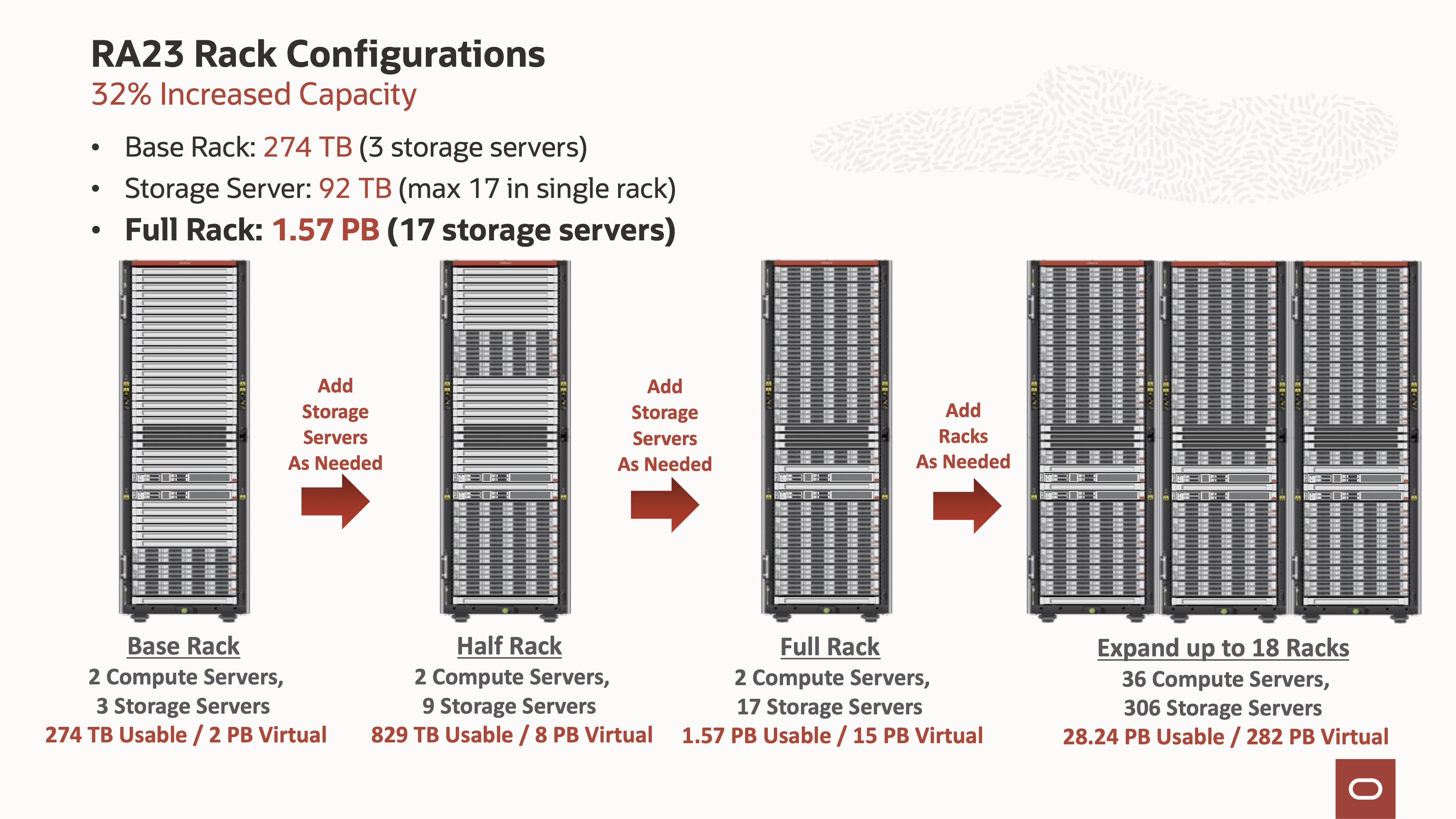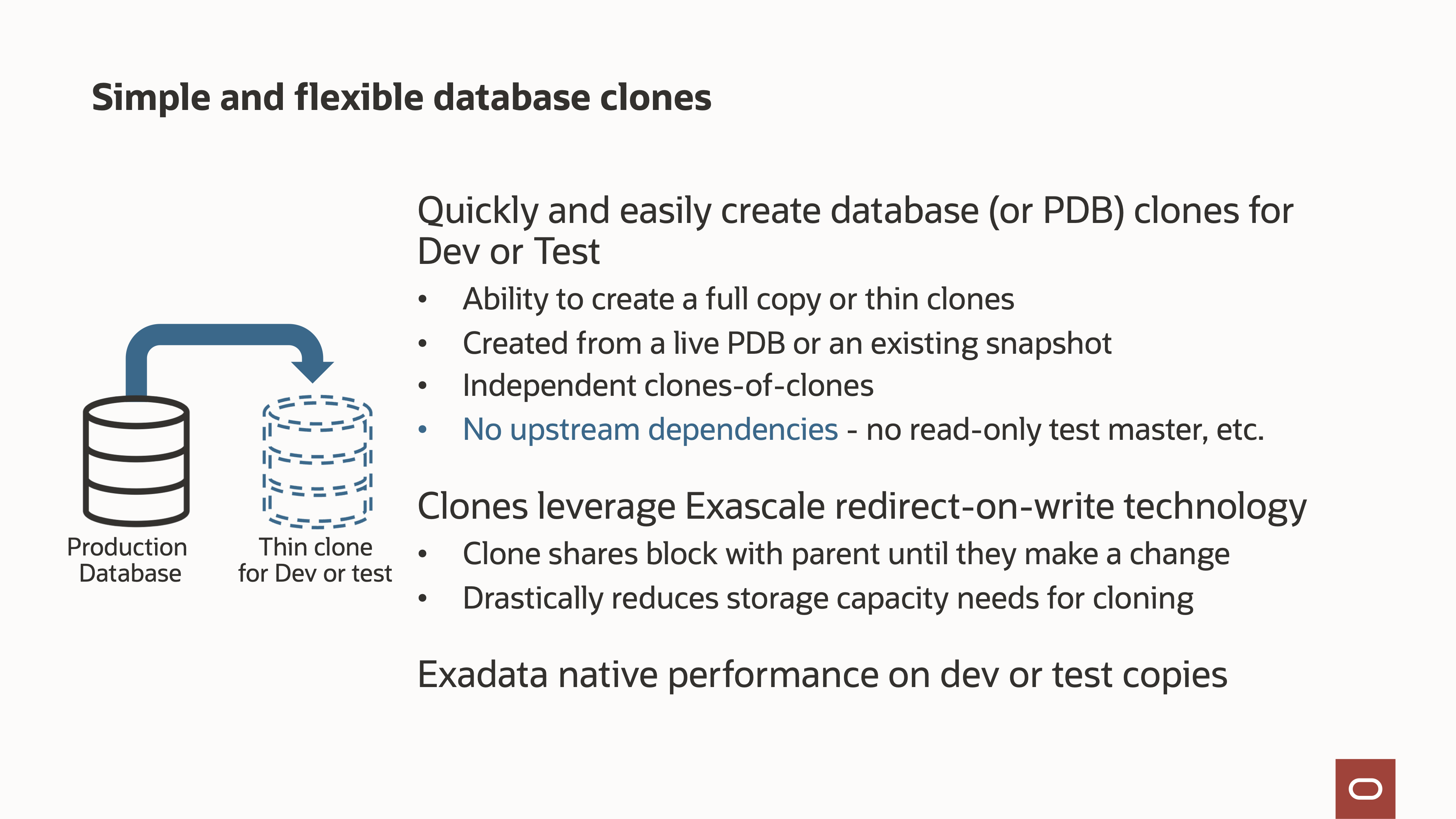December? Already! It feels like it was January just a few short months ago. It’s been a pretty big year by any measure and before we all (hopefully) take some much-deserved time to spend with family and friends, I thought a quick recap of the year would be interesting. As perhaps the greatest fictional philosopher of this year said – “I think things come into our lives to help us get from one place to a better one.” — Ted Lasso. And while Exadata may not have been the subject of Ted’s quote at the time – if he were an Exadata customer, I’m sure he’d agree the Exadata family is also one of those “things”. I hope you agree too.
2023 has been a significant year for the core Exadata platform. First, in March, we released Exadata System Software 23.1, followed soon after by Exadata X10M in June. As has always been the case, Exadata is a combination of hardware and software architected together to be the best platform for running Oracle Database. Let’s take a closer look at both these releases.
Exadata System Software 23.1
Exadata System Software (ESS) 23.1 updated the operating system and overall ecosystem to Oracle Linux 8 (OL8) and UEK6 from Oracle Linux 7 and UEK5. Performed in a rolling manner across database and storage servers, the update to OL8 and UEK6 is fundamental to our mission – to be the best platform for Oracle Database. In this context, OL8 is required for the upcoming release of Oracle Database 23c – the next long-term support release.
Exadata RDMA Memory (XRMEM) was also introduced in ESS 23.1 – at first glance, a simple name change to reflect the greater importance of RDMA, but as we will discuss shortly, foretold of a move to faster DDR5 memory for OLTP data caching. But, I’m getting ahead of myself. As the name is intended to imply, Exadata RDMA Memory uses RDMA from the database servers to access data in the storage servers. The primary use case is the caching of OLTP data in an even faster medium than Flash. On X8M and X9M storage servers, XRMEM enables 8K reads to be performed at just less than a staggering 19 microseconds (μs). In X10M, read latency drops even more (spoiler alert – as low as 17 μs).
Our customers are keenly interested in security, and as a security-focused organization ourselves, we regularly add features and improvements that assist our customers in strengthening their security. Centralized Identification and Authentication of OS Users is such a feature and brings LDAP and Kerberos support to the base installation, enabling customers to enroll their non-service or real-user accounts on database and storage servers with a central LDAP environment. Centralized LDAP and strong authentication of OS accounts are important for customers to ensure resources that store and process sensitive data, much of which is entrusted to Oracle Database on Exadata, are accessible only to administrators and users that should have access.
Exadata X10M
June saw the release of Exadata X10M – the 12th generation of the Exadata Database Machine – the premier platform for running Oracle Database. Exadata X10M is a watershed release bringing with it improvements across the entire hardware ecosystem and leveraged by the intergrated Exadata System Software. The net result is an increase in processing capability that enables up to 3x higher transaction throughput and up to 3.6x faster analytic queries on database servers to enable superior performance for OLTP and analytics workloads, lower read latency, higher capacity, and greater consolidation of Oracle Databases.
I encourage you to watch Juan Loaiza’s announcement of Exadata X10M below.
It is worth covering a few specific components in a little detail. Fourth-generation AMD EPYC™ processors were introduced across the entire range of database and storage servers. In the database servers, the number of cores increases from 64 to 192 per server, and in the storage server from 32 to 64 per server, compared to X9M.
Storage capacity was increased across the board with X10M. High Capacity (HC) and Extended Storage (XT) Servers moving to 22 TB disk drives. More significantly, the Extreme Flash (EF – all-flash) servers introduced 30.72 TB Capacity-optimized Flash SSDs, a substantial 2.4x increase over the previous generation.
X10M updated the storage server with 1.25 TB of Exadata RDMA Memory (using DDR5 DRAM) to drive down OLTP read latency to a phenomenal less than 17 μs. Database server memory was also updated to DDR5 memory with more and higher memory configurations available, starting at 512 GB with 1.5 TB, 2.25 TB, and 3 TB options available. The combination of higher-density CPUs and larger memory (along with many other improvements) enables X10M 2-socket database servers to perform the same function as the 8-socket database servers of previous generations in a smaller form factor, and with lower power and cooling requirements.
Take a look at the Data Sheet for all the details!

Exadata Cloud and Autonomous Dedicated
Exadata Cloud@Customer X10M also debuted in June, incorporating all the hardware and software features of the on-premises platform including the move to fourth-generation AMD EPYC™ CPUs, Exadata RDMA Memory, and higher capacity storage. Moreover, Exadata Cloud@Customer continuously released new capabilities through the OCI console including:
- Multi-Rack Elastic Compute and Storage Expansion
- Interim Software Updates
- Exadata Fleet Update (available for both Exadata Cloud@Customer and Exadata Database Service on Dedicated Infrastructure – overview blog)
- Single VM Clusters
- and much more.
Oracle Autonomous Database on Exadata Cloud@Customer also saw a steady stream of new capabilities such as Autonomous Exadata VM Cluster Node Subsetting, Long-Term Backups, and In-Memory Column Store Support to name a few of my favorites.
Not to be outdone, Exadata Database Service on Dedicated Infrastructure (ExaDB-D) also unveiled a series of new features including Application VIP Support, Monthly Infrastructure Security Maintenance, Interim Software Updates, and Autonomous Recovery Service as the Default Backup Destination for database and service administrators that enjoy the confluence of automation and data protection.
Last, but certainly not least, Oracle Autonomous Database on Dedicated Exadata Infrastructure also announced an avalanche of useful resources, support for Real Application Testing (RAT) Database Replay, Parallel Replicat in Integrated Mode for GoldenGate users, and snapshot standby database in an Autonomous Data Guard setup support.
Zero Data Loss Recovery Appliance
For those that may not be aware, Zero Data Loss Recovery Appliance – Recovery Appliance (RA) for short is Oracle’s recommended solution for data protection. Protected databases continually log changes to the Recovery Appliance to enable customers to recover databases to within less than a second in the event of an outage or ransomware attack. Implementing an incremental forever approach to database protection, automated recovery, and sophisticated security, Recovery Appliance is the best backup and recovery solution for Exadata.
July saw the release of the RA23, the next generation of Zero Data Loss Recovery Appliance. RA23 includes increased backup capacity by virtue of the new 22 TB drives. In a Base Rack configuration, this equates to 274 TB of usable physical storage, and an impressive 2 PB of virtual full backup storage using an incremental forever strategy and a 10% daily change rate among the protected databases. Looking at the full rack configuration (17 storage servers), these figures jump to 1.57 TB physical and 15 PB virtual capacity!

Also introduced in RA23 is the option to use 100 GbE network interface cards. 100 GbE is increasingly becoming the standard network fabric in data centers. This option, in combination with RA23 ToR switches, enables Exadata customers to create a dedicated backup and restore network supporting 35+ TB/hour throughput, alleviating corporate network infrastructure from the burden of handling database backup and recovery operations.
WIth the ever increasing visibility of cyber and ransomware attacks making headlines, Recovery Appliance offers Oracle-integrated resilient data protection, driving down data loss exposure to less than a second and driving up recovery performance to 35+ TB/hour. Offering capabilities such as continual recovery validation, backup immutability, separation of duty, and quorum user approval – all while supporting a cyber vault architecture – the Recovery Appliance is the first and only database-engineered protection platform in the industry. Learn more about these innovations in our recent webinar: Oracle’s Zero Data Loss Recovery Appliance Ransomware Protection Architecture & Cyber Vault Services.
Exadata Database@Azure
Just before Oracle CloudWorld in September, Larry Ellison and Microsoft’s Satya Nadella announced the upcoming availability of Oracle Database Services on Oracle Cloud Infrastructure in Microsoft Azure – Oracle Database@Azure for short. Available in December 2023, Oracle Database@Azure will see Oracle Database on Exadata infrastructure available to Azure customers from within the Azure console for ease of provisioning and integration with other Azure services – and more importantly, from within the Azure cloud regions to reduce latency to mission-critical data and Oracle databases.
Grab a coffee and watch the announcement video below – it’s worth it. Go on – I’ll wait.
Exadata Exascale
At DatabaseWorld at Oracle CloudWorld in Las Vegas, Exadata Exascale was previewed. Exascale is the next-generation software architecture and will bring significant enhancements to the Exadata family and more importantly, to our customers. Designed with hyper-scalability, multitenancy, security, high availability, and performance as core principals, Exascale builds on the existing hardware and software features of Exadata while adding an impressive array of storage and resource management features.

One significant area of enhancement coming with Exadata Exascale is the completely new database snapshot and cloning capabilities. To even more closely meet our customers’ requirements, Oracle Database 23c and Exascale will no longer require cloned databases to be read-only or need a dedicated diskgroup for sparse data files. Clones and snapshots, which are thin by default and design, can be taken from any live database or PDB and will be independent of the source, meaning once a clone is created, the source can be dropped (if no longer needed) without impacting the clone itself.

Many other features and enhancements are planned for Exadata Exascale and I’ll introduce and write about these at a later time. As a teaser, Exascale, along with other features being developed, will enable VM migration between database servers for planned maintenance – a feature that will enable customers to maintain software and physical hardware with far reduced (to no) impact on the databases and applications.
Exadata Database Service on Exascale Infrastructure
Also previewed at CloudWorld was the Exadata Database on Exascale Infrastructure (ExaDB-XS), a cloud service that implements the Exascale architecture and features. When this service is available, customers will be able to deploy Oracle Database 23c on a hyper-scale, multitenant Exadata Cloud platform without subscribing to dedicated infrastructure as is the case for the ExaDB-D service today. Ultimately, this will enable customers to create single VM clusters with as few as two CPU cores and a couple of hundred GB of usable capacity and pay for only the capacity they are using with easy scale-up and scale-out characteristics.

Wrap up
So, as you can see, 2023 was yet another busy year for the Exadata Engineering and Product Management teams. And 2024 is shaping up as an even bigger year with a plethora of new features, capabilities, and enhancements to delight even the most hardened DBA, and it will all start with Oracle Database 23c. New AI capabilities, simplified application development, enriched JSON and Graph features, embedded SQL Firewall, advanced application-side data caching, and enhancements to high availability, upgrade, and practically every aspect of the database make this release your next long-term support release. Oh, and did I mention Exadata will uniquely optimize and enhance many of these features, holding true to our mission of being the best platform for Oracle Database.
On that note, I’d like to thank the Exadata development group – these dedicated individuals strive daily to improve every aspect of the Exadata platform. Oracle Exadata is a more incredible platform for the vigorous and cooperative approach taken in its development.
I’d also like to thank the Sustaining Engineering and Support teams. These fine people ensure Exadata enables our customers to meet their objectives. Thanks also go to our sales, marketing, service, and back-office teams that help our customers achieve incredible results.
Finally, to you, our customers and partners – an enormous Thank You for proving day after day that Exadata is the premier platform to run Oracle Database!
So, from all of us here in Exadata product teams, have a safe and wonderful holiday season. We’ll see you all again in 2024!
